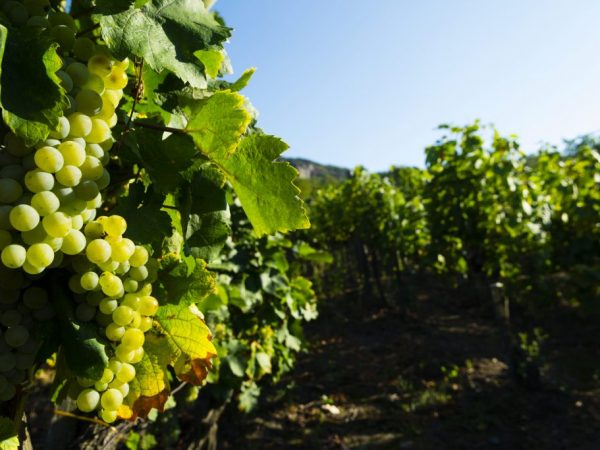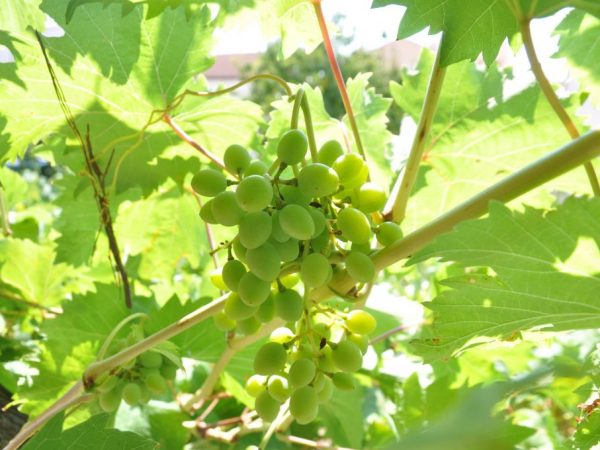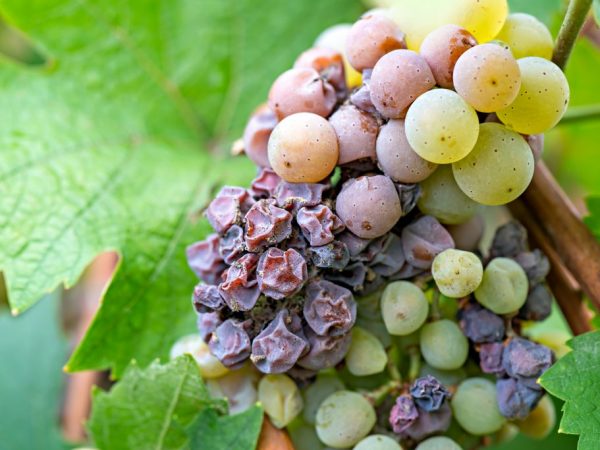Vanyusha grapes
Grapes are a perennial plant. The berries are processed into juices, wines, compotes and preserves. Vanyusha grapes are one of the most popular varieties for self-cultivation.

Vanyusha grapes
Characteristics of grapes
Vanyusha grape variety belongs to white table varieties. The plant is characterized by an early ripening variety. Ripe berries appear in late June and early August.
The period of fruit ripening from the beginning of the growing season is 125 days, it is a hybrid variety obtained from mixing the varieties Kesha and Black Autumn. The disadvantage of the variety is a strong indicator of shattering of berries after ripening, as well as poor frost resistance.
Description of the bush
Vanyusha grapes have strong and fast-growing bushes. The leaves are large, bright green with thin light veins.
The variety is also characterized by a high load on the branches, which is constantly increasing. Up to 40 eyes appear on one branch, which causes the branches to break off from the severity.
Description of fruits
- Vanyusha grapes have large clusters of elongated shape. The average weight of one is 1200 g. The density of the vine is good.
- The berries are large (17 g) in size. They are round or oval in shape.
- The fruits are yellow-green in color. When ripe, a pinkish haze appears. The berries are covered with a dense, but not thick skin.
- The description of the pulp is similar to that of other white varieties. It is soft, juicy and meaty. The taste is sweet with a slight sourness.
Growing grapes
Vanyusha grapes are best propagated by cuttings. It ripens quickly and adapts well to new conditions.
The variety does not tolerate rainy weather, negatively affects pollination. In rainy conditions, the ovaries are treated with special means.
Landing in the soil
Description of the disembarkation procedure:
- Choosing a place. It should be well lit and protected from the wind.
- Digging a hole. It should be 35-40 cm deep. The bottom ball of soil is filled with water.
- Disembarkation of the shank. It is placed in the ground, sprinkled on top with a layer of soil, without tamping.
Vanyusha grapes do not require planting several cuttings in the ground. Its silt root can be limited to 1 shank.
Plant care

The bush needs shaping
For the winter, grape seedlings are covered with a special material so that it can withstand low temperatures. The variety has an average winter hardiness, therefore, it requires hilling with soil. In the spring they take it off when it gets warm. Also during this period, all water is removed from the soil surface so as not to cause a disease of the bush.
In the summer, regular pinching is carried out so that it does not grow above 2 m. In the fall, they begin to prepare the bushes for wintering. After harvesting and foliage falling, pruning is carried out, leaving the strongest branches.
Fertilizer
The first set of fertilizers is applied to the soil along with planting. Later, organic fertilizers are applied.
Natural dressings:
- manure;
- peat;
- bird droppings.
Mineral dressing is also required. The first is applied dry, after removing the winter shelter. The second is carried out 2 weeks before flowering. Fertilizers are also applied when the first ripe fruits appear.
Types of mineral fertilizers:
- Nitrogen. Urea and ammonium nitrate are used.
- Potash. Potassium salt, Ecoplant, as well as sulphate or potassium chloride are introduced.
- Phosphoric. It is useful to add double superphosphate in the form of granules.
- Difficult. Effective mineral complexes are Master, Solution and Kemira.
Watering
Vanyusha grapes require regular watering. The first time, moisture is applied after removing the winter cover along with fertilizers.
Young bushes are watered through pipes that supply moisture to the root system. One plant requires 40 liters. warm settled water. You can also add wood ash.
The second time, moisture is applied 10 days before the beginning of flowering. The last time the grapes are watered after the end of the period. Also, moisture is introduced before the beginning of winter to charge the bush with moisture.
Diseases and pests
Vanyusha grapes have a weak immunity to diseases. He is prone to the appearance of fungal diseases and harmful insects.

The plant is prone to fungal diseases
Possible diseases:
- oidium;
- mildew;
- antaracosis;
- gray rot;
- aphid;
- phylloxera.
For their treatment, agrotechnical measures are carried out, and the bushes are also treated with chemicals. Additionally, grapes are treated with folk remedies.
Fight disease
The fight against ontaracosis is carried out with the help of fungicides. Effective remedies are Thanos, Horus, Acrobat and Ridomylon. These are devices of the contact method of application.
To cure grapes from powdery mildew, they carry out a regular garter and pruning of branches. Topaz, Tiovit and Strobi also help with dew.
Mulching and potash fertilization helps with mildew. It is also required to remove all affected stepsons and shoots. Of the chemicals from mildew, Antrakol helps. Treatment with fungicides helps from gray rot, and treatment with copper sulfate helps from spotting.
Pest control
To combat phylloxera, the following means are used:
- Confidor;
- Actellik;
- Zolon.
To eliminate the caterpillar of harmful insects, the bushes are treated with Nitrafen. When butterflies appear, use Karbofos or Actellic.
Prophylaxis
In order to prevent the appearance of diseases on the bushes, all cultivation rules must be observed. Vanyusha grapes are required to be regularly examined for the presence of harmful insects and fungal diseases.
Regular feeding saves from the appearance of diseases. Also, waterlogging of the soil should not be allowed, since fungi love a moist environment.
Conclusion
Vanyusha grapes are suitable both for their own consumption and for growing for sale. They tolerate transportation and storage well. To choose a quality seedling, you need to carefully examine it. It should be free of damage or signs of rot or fungus.


